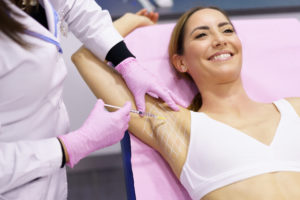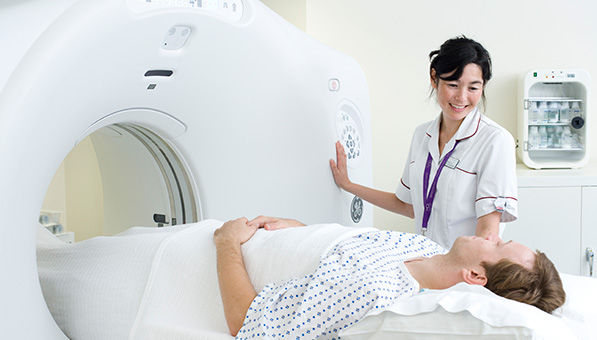Hyperhidrosis Treatment in Harley Street, London
Hyperhidrosis Treatment
At The Devonshire Clinic, our consultants can offer several treatments which can help with hyperhidrosis (excessive sweating). Your doctor will recommend some that you can use as self-help first of all. If these do not help improve your excess sweating or enable you to manage your condition, we can explore more medical hyperhidrosis treatment options. We provide medical hyperhidrosis treatments at our clinic in the Harley Street area of London.
Medical Treatment Of Hyperhidrosis
To help manage hyperhidrosis, the first agents to try are topical products that can help to absorb the excess sweat, such as talcum powder and cornstarch powder (e.g. Zeasorb®). These are usually only helpful in mild cases.
Stronger antiperspirants containing aluminium chloride e.g. Driclor ® and AnHydrolForte® can be used for armpits, hands and feet. They are applied 2-3 times a week at night and washed off in the morning to avoid damage to clothes. Application can be effective especially for underarm sweating. However, they can cause the skin to become irritated over time. If this happens you should consult your doctor.
Botulinum toxin injections
Botulinum toxin injections provide an effective treatment to cure hyperhidrosis in many people.
Treatment involves injecting small doses of the same agents used to aid skin wrinkles into the skin of the affected areas. They work by blocking the action of nerves that supply the eccrine (sweat) glands. This stops the glands from producing sweat.
Treatment totally blocks the nerve ending for about 6-12 weeks, but then new nerve endings start to form. This means the effects of the treatment of hyperhidrosis lasts for several months but will eventually wear off.
How to prevent hyperhidrosis hands?
You will need a number of small injections with a fine needle into the affected areas such as your armpits. The injections may cause some discomfort and your skin may be slightly red and inflamed immediately after treatment. This normally resolves within a few hours.
Are there any side effects?
Side effects include bruising or tenderness at the injection sites and increased sweating at other sites. Rare side effects include itching, muscle aches, allergic reactions and muscle weakness.
How long does it take to work?
Most patients notice some positive changes within the first week after treatment. The effects usually last between 4-7 months.

Other hyperhidrosis treatment in UK
Iontophoresis
Iontophoresis involves immersing the parts of your body where the worst of your hyperhidrosis symptoms occur in warm water. A mild electric current is then passed through the immersion fluid. Some clinicians add glycopyrrhonium bromide to enhance the effects.
Because your body’s natural electrical charge is negative, positive ions in the water induced by the current flow straight through the sweat ducts, interrupting the sweating process by an unknown mechanism.
Iontophoresis has been in clinical use for several decades and is not dangerous. Few people report discomfort, apart from some tingling, and sometimes a dry mouth.
To become effective, iontophoresis is usually delivered in multiple treatment sessions and maintenance sessions are necessary to help manage your hyperhidrosis.
Surgery for hyperhidrosis
Surgical procedures may be considered when other methods have been tried first. Two types of surgery are available:
Subcutaneous sweat gland curettage
Over-active sweat glands are removed under general anaesthetic. The procedure can reduce sweating by up to 50% in many cases.
Transthoracic sympathectomy
This involves cutting the nerves that supply the sweat glands. If necessary, the surgeon performs partial removal of the involved nerve fibres and ganglia in the spine (T2 and T3) under general anaesthetic. This eliminates excessive hyperhidrosis in the hands and underarms and is permanent. It is an effective treatment for severe hyperhidrosis on the palms and under the arms but there is between 40-69% risk of compensatory hyperhidrosis in which new areas of excessive sweating develop, usually on the trunk and lower parts of the body).
Enquire about
Hyperhidrosis Treatment in Harley Street, London
Frequently Asked Questions Hyperhidrosis Treatment
Your treatment will depend on what kind of hyperhidrosis you have and where on your body it most affects you. You may be able to manage the condition yourself by reducing your stress levels, avoiding certain foods, and using skin products that help absorb excess sweat, and antiperspirants which you can use on your hands, feet, armpits, and hairline. Iontophoresis involves immersing affected parts of your body in warm water, while a mild electric current interrupts the sweating process. Other treatments include Botox™ injections to the sweat glands, prescription medicine, and in some cases, surgery to remove sweat glands.
While it’s normal to sweat if you’re hot or exercising, hyperhidrosis is when you sweat excessively. It’s a common condition, which can affect your whole body or just a few areas. Hyperhidrosis can happen without an apparent cause, or it can be triggered by something else, such as anxiety or eating particular foods. It can sometimes be related to another medical condition, such as heart disease, or it can be a side-effect of medication. Hyperhidrosis can be distressing and embarrassing because your body sweats even when it doesn’t need to cool down. Sometimes, the more self-conscious you become, the worse the condition becomes.
Up to half of people with primary focal hyperhidrosis (mainly affecting the hands, feet, face, head, and armpits) have a family history of the condition. With secondary generalised hyperhidrosis, it’s usually related to illness or a hormonal condition such as diabetes or the menopause, or it can be a side-effect of certain medications.
If excessive sweating mainly affects your hands, feet, face, head and under your arms, it’s known as primary focal hyperhidrosis, which usually starts in childhood. If your hyperhidrosis is caused by medication or is related to a medical condition, it’s known as secondary generalised hyperhidrosis.
Your doctor will examine you to check for your most affected areas. They’ll also ask whether you have any other health problems, are on medication, and whether there’s a family history of the condition. You might also have a ‘sweat test’, which involves putting powder on the affected skin that changes colour when wet.
Although losing weight won’t cure your hyperhidrosis, it may mean you sweat less when you are active.
If you have mild hyperhidrosis, you may be able to manage your symptoms through lifestyle changes such as wearing loose clothing, using antiperspirants, managing anxiety, and avoiding spicy foods. Skin products such as talcum powder and cornstarch powder can help absorb excess sweat.
Most hyperhidrosis treatments are not permanent. For example, Botox™ injections to the armpits last 4-7 months, and you’ll need maintenance sessions of iontophoresis treatment. Surgery can provide a more permanent solution, in many cases reducing sweating by up to 50% in the treated areas. However, depending on the type of surgery, new areas of excessive sweating may develop over time.
Read our
Patient Stories
I can’t recommend this clinic highly enough. The treatment I received for my skin cancer was first class
AL, LondonThe team at the Devonshire Clinic were excellent. From booking my appointments to every part of my treatment, I felt that I was in the very best hands.
CH, LondonBefore visiting the clinic I had quite high expectations, but I was blown away by just how brilliant the experience was. I felt like I was the only patient in the clinic. Simply the best medical treatment.
SF, London

